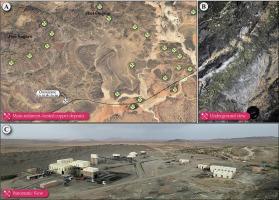摩洛哥东反阿特拉斯Oumjrane脉系沉积型Cu-(Ni)和Pb-Zn-Ba矿化时间及其与前白垩世中大西洋和马格里布特提斯地球动力学的相关性
IF 7.2
1区 地球科学
Q1 GEOSCIENCES, MULTIDISCIPLINARY
引用次数: 0
摘要
构造控制脉型Oumjrane Cu-(Ni-Pb-Zn-Ba)区(5.7 Mt,含1.5% Cu)由一个25 × 25 km宽的陡倾ENE- to - e -w向石英-硫化物断裂脉系组成,由第一组(Upper Darriwilian-Sandbian)和第二组(Hirnantian) Bani组的一系列奥陶系低品位含磷硅质变质沉积岩组成。根据构造关系和矿物组合,确定了两个主要的硫化物断脉充填事件。早期成矿期铜矿富铜,经济上产量最高,主要由黄铜矿与次级辉石(nias)和磁铁矿组成,与石英和磷灰石紧密共生。后期铅锌钡事件以方铅矿和闪锌矿为主要硫化物,包裹在以重晶石和磷灰石-2为主的基质中。利用两次成矿事件中与矿相关的磷灰石的主微量元素化学和LA-ICP-MS U-Pb定年,确定了成矿的绝对年龄和相关的地球动力学背景。第一次富铜事件的年龄为175.6±1.1 Ma (MSWD = 1.3),第二次富铜事件的年龄为151.3±3.1 Ma (MSWD = 0.46)。第一次铜事件中磷灰石-1的微量元素组成反映了以Cl -和OH -为主的区域循环和SO42 -为主的岩石缓冲体系中热液盆地盐水的参与。相反,晚期Pb-Zn-Ba事件的磷灰石-2化学性质与岩浆-热液成因一致。高的流岩比可能导致金属的运移,并通过e- e- w向断裂进入热液系统,这是成矿流体向上流动的通道。从地球动力学角度看,新的U-Pb年龄与马格里布特提斯超伸展的连续高峰和中大西洋被动边缘形成的初始阶段有关。值得注意的是,这些后variscan辐射测年提供了新的见解,挑战了之前建立的Anti-Atlas铜带成因模型的时间表,将其定位在北非和欧洲更广泛、丰富的成矿时期。本文章由计算机程序翻译,如有差异,请以英文原文为准。

Timing of the telescoped sediment-hosted Cu-(Ni) and Pb-Zn-Ba mineralization at the Oumjrane vein system (Eastern Anti-Atlas, Morocco) and its relevance to Pre-Cretaceous Central Atlantic and Maghrebian Tethys geodynamics
The structurally controlled vein-type Oumjrane Cu-(Ni-Pb-Zn-Ba) district (5.7 Mt at 1.5 % Cu) consists of a 25 x 25 km-wide system of steeply dipping ENE- to E-W-trending quartz-sulfide fault veins hosted in a succession of Ordovician low-grade phosphorus-bearing siliciclastic metasedimentary rocks of the first (Upper Darriwilian-Sandbian) and second (Hirnantian) Bani Groups. Based on textural relationships and mineral assemblages, two major sulfide fault-vein infill events are recognized. The early event, which is copper-rich and economically the most productive, consists of chalcopyrite with subordinate gersdorffite (NiAsS) and magnetite, closely intergrown with quartz and apatite-1. The later Pb-Zn-Ba event comprises galena and sphalerite as the principal sulfides embedded in a barite-dominated and apatite-2 matrix. Major and trace element chemistry and LA-ICP-MS U-Pb dating of ore-related apatite from both mineralization events are used to determine the absolute age(s) of mineralization and related geodynamic setting(s). The obtained ages are 175.6 ± 1.1 Ma (MSWD = 1.3) for the first copper-rich event, and 151.3 ± 3.1 Ma (MSWD = 0.46) for the later lead-zinc-barite event. The trace element composition of apatite-1from the first copper event reflects the involvement of regional circulation of predominantly Cl− and OH–, and SO42− hydrothermal basinal brines in a dominantly rock-buffered system. Conversely, apatite-2 chemistry from the late Pb-Zn-Ba event is consistent with a magmatic-hydrothermal origin. High fluid-rock ratios would have resulted in mobilization of metals and their transport into the hydrothermal system through the ENE- to E-W-trending faults which acted as pathways for the upward flow of the ore-forming fluids. From a geodynamic perspective, the new U-Pb ages correlate with the successive peak of the hyper-extension of Maghrebian Tethys and initial stages of Central Atlantic passive margin formation. Remarkably, these post-Variscan radiometric dates offer new insights challenging the previously established timeline for the Anti-Atlas copper belt genetic models, situating it within a broader, rich metallogenic period in North Africa and Europe.
求助全文
通过发布文献求助,成功后即可免费获取论文全文。
去求助
来源期刊

Gondwana Research
地学-地球科学综合
CiteScore
12.90
自引率
6.60%
发文量
298
审稿时长
65 days
期刊介绍:
Gondwana Research (GR) is an International Journal aimed to promote high quality research publications on all topics related to solid Earth, particularly with reference to the origin and evolution of continents, continental assemblies and their resources. GR is an "all earth science" journal with no restrictions on geological time, terrane or theme and covers a wide spectrum of topics in geosciences such as geology, geomorphology, palaeontology, structure, petrology, geochemistry, stable isotopes, geochronology, economic geology, exploration geology, engineering geology, geophysics, and environmental geology among other themes, and provides an appropriate forum to integrate studies from different disciplines and different terrains. In addition to regular articles and thematic issues, the journal invites high profile state-of-the-art reviews on thrust area topics for its column, ''GR FOCUS''. Focus articles include short biographies and photographs of the authors. Short articles (within ten printed pages) for rapid publication reporting important discoveries or innovative models of global interest will be considered under the category ''GR LETTERS''.
 求助内容:
求助内容: 应助结果提醒方式:
应助结果提醒方式:


